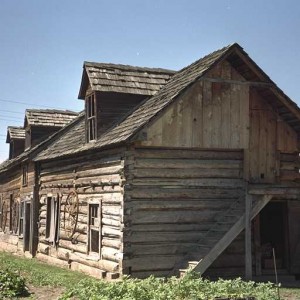Second Casorso House
Place Description
The historic place is the 1.5-storey, log Second Casorso, House built in stages between about 1886 and 1891 in the pioneer vernacular manner, and located at 3877 Casorso Road in Kelowna's Southeast Sector.
Heritage Value
The original Casorso homestead of 320 acres is the oldest family farm in Kelowna, still operated by members of the Casorso family some 120 years after Giovanni Casorso pre-empted it in 1884. Over the years the Casorsos have been pioneers in a wide range of agricultural production: cattle, hogs, vegetables, tobacco, fruit, and grapes. In his old age, Giovanni Casorso was involved in the establishment of Kelowna's first winery, which became Calona Wines. One of the first-ever mobile sprinkler systems, invented about 1912 by Clem Vacher, was set up on this property. The road on which this building stands was named after Giovanni Casorso.
Giovanni ('John') Casorzo (the spelling was altered by a schoolteacher in the 1880s) left his birthplace in the Piedmont area of Italy in 1882, looking for new opportunities in North America, he made his way across the continent and in July 1883 met Father Pandosy in New Westminster and was offered employment at the Oblates' Okanagan Mission. While working for the Oblate fathers, Casorzo pre-empted land across Mission Creek.
The first Casorso home was a one-room, sod-roofed, earth-floored log cabin near the Mission, which Giovanni built before his wife Rosa and three children arrived in 1884. Casorso and his young family worked hard clearing land, gardening, and acquiring their first stock.
After completing a barn on his pre-emption in 1885 (animals always come first on a farm), Casorzo turned to accommodation for his growing family. He began work in 1886 on the first two rooms of this long, log, gable-roofed house. It was built in three stages. The first two stages were made of round logs; the third stage, built around 1891, used squared logs, representing a more sophisticated manner of construction.
Situated beside the main trail along the east side of Okanagan Lake, the house became a popular stopping-place for travellers, providing income for the Casorsos in lodging and feeding both people and horses. Over time the Casorsos cleared more acreage and built up a herd of cattle.
This house housed the Casorso family (nine children eventually) until 1907, when improved financial circumstances permitted them to build of a larger frame house (3860 Casorso Road). After the family's move to the new house, this building served as a bunkhouse for ranch h
Character Defining Elements
- Pioneer vernacular log construction
- Clearly shows the staged evolution of the building
- Round-log walls with saddle-notched joints in the earlier stages; squared-log walls with dovetail joints in the later portion
- Gabled roof, cedar shingles, and three gabled dormer windows
- Wood-sash, double-hung windows on ground floor
- Original stone foundation
- Set on a large farm with cornfields, large vegetable garden, and grassy areas





